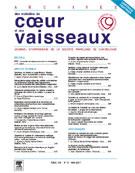Étude d’une stratégie de détection de l’ischémie silencieuse chez les patients diabétiques : suivi à 18 mois du registre ARCADIA. - 26/03/08
G. Vanzetto [1],
S. Halimi [2],
O. Ormezzano [1],
J. Steidel [1],
L. Belle [3],
R. Boizel [2],
D. Fagret [4],
J. Machecourt [1]
Voir les affiliationsContexte : L’impact pronostique d’une stratégie de détection de l’ischémie myocardique silencieuse (IMS) chez les patients diabétiques asymptomatiques demeure controversé. Le registre non-randomisé ARCADIA a pour but d’évaluer le bénéfice d’un algorithme thérapeutique basé sur la clinique et la tomoscintigraphie myocardique (TSM) sur la survenue d’événements cardiovasculaires chez ces patients.
Méthodes : Sept cent un patients diabétiques asymptomatiques ont été stratifiés à partir de treize paramètres biocliniques. Les patients à haut risque ont bénéficié d’une TSM, puis d’un traitement soit conventionnel (groupe 1, n = 180), soit intensif (groupe 2, n = 245). Les patients à faible risque (groupe 3, n = 276) ont été simplement suivi.
Résultats : A dix-neuf mois, du fait de la stratégie intensive, hypocholestérolémiants, antiagrégants plaquettaires, et β-bloquants étaient plus souvent prescrits dans le groupe 2 que dans le groupe 1 (respectivement 55, 31 et 17 % contre 36, 23, et 8 %, p ≪ 0,01). De même, les coronarographies (en cas d’IMS étendue) et les revascularisations myocardiques programmées étaient plus fréquentes dans le groupe 2 (16,2 et 8,9 % versus 8,0 et 2,8 % - p ≪ 0,01). A 19 mois (suivi 96,7 %), les événements cardiovasculaires ont été significativement réduits dans le groupe 2 par rapport au groupe 1 (3,9 contre 9,8 %, p ≪ 0,01) et revenu au niveau du groupe 3 (2,2 %, NS).
Conclusion : Une stratification simple permet de détecter des patients diabétiques asymptomatiques présentant un bon pronostic à moyen terme. Chez les patients à haut risque, un traitement médical intensif associé à une coronarographie ± revascularisation myocardique en cas d’IMS étendue permet d’améliorer le pronostic cardiovasculaire.
Study of a detection strategy for silent ischemia in diabetic patients: 18 month follow-up of the ARCADIA register. |
Background : The prognostic impact of a myocardial ischemia-based therapeutic program in asymptomatic diabetic patients remains controversial. We prospectively assessed the benefit of a stratification algorithm based upon clinical and myocardial perfusion imaging (MPI) data on cardiovascular events in such patients in a non-randomized register.
Method : 701 consecutive asymptomatic diabetic patients were classified to be at low or intermediate-to-high cardiac risk according to 13 simple boil-clinical parameters. Intermediate-to-high risk patients were scheduled for MPI and underwent either a conventional (Group 1, n = 180) or an intensive multifactorial (Group 2, n = 245) therapeutic program. Low risk patients (Group 3, n = 276) underwent no specific management.
Results : At the end of the survey and as a consequence of intensive management, lipid lowering therapy, antiplatelet drugs, and β-blockers were more often prescribed in Group 2 than in Group 1 (55, 31 and 17 % versus 36, 23, and 8 % respectively, p ≪ 0.01). Planned coronary angiography in case of severe ischemia on MPI and revascularization were more frequent in Group 2 (16.2 and 8.9 %) than in Group 1 (8.0 and 2.8 % - p ≪ 0.01). At 19-month follow-up (96.7 % completed), major event rate in Group 2 was significantly lower than in Group 1 (3.9 versus 9.8 %, p ≪ 0.01) and similar to that of Group 3 (2.2 %, NS).
Conclusion : Easy-to-perform risk stratification is able to select diabetic patients with good medium-term prognosis. In clinically selected higher risk patients, an intensive medical therapy combined with coronary angiography ± revascularization in case of large ischemia on MPI is effective to improve prognosis.
Mots clés :
Diabète
,
coronaropathie
,
scintigraphie
,
pronostic
Plan
© 2007 Elsevier Masson SAS. Tous droits réservés.
Vol 100 - N° 10
P. 845-852 - octobre 2007 Retour au numéroBienvenue sur EM-consulte, la référence des professionnels de santé.

